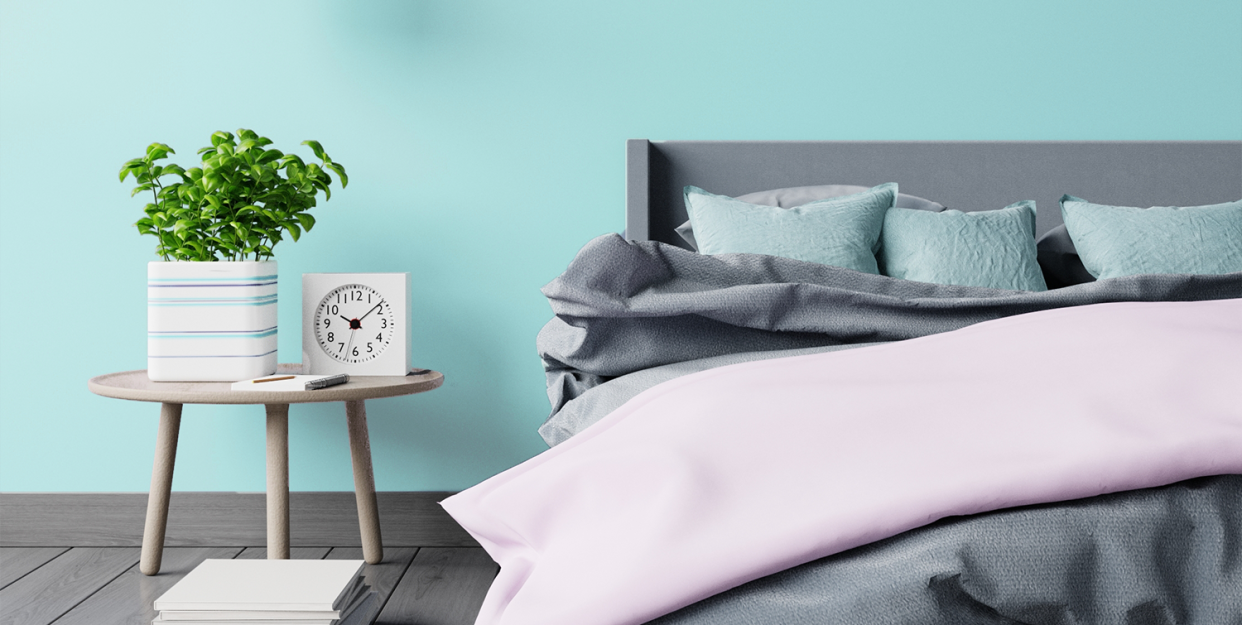If You Hate a Top Sheet, You NEED a Duvet — Here's Why

When designing your Pinterest-worthy bedroom, the best place to start is your bed. It takes up the most space in your room and it is where you spend the most time. Once you have the basics — a comfy mattress, plush pillows and soft sheets — you can start to add more flair and cozy elements. A duvet cover is an easy way to add style to your bed without the commitment of a brand new comforter because, no, a duvet cover is not the same thing as a comforter.
What is a duvet cover?
A duvet cover surrounds your duvet insert to keep it protected and clean. It is like a massive pillowcase for your duvet. A duvet cover is typically designed with simple loops or tabs on the inside corners and sides that attach to your duvet insert to keep it in place. Button closures or zippers along the bottom of the duvet cover keep the duvet insert secure and clean.
A duvet cover can be changed with the season, temperature or based on your mood or even a whole bedroom makeover. If you hate making your bed, a duvet cover can even replace your top sheet if you wash the cover with your fitted sheet and pillowcases regularly.
Duvet vs. comforter
A duvet is an insert that is stuffed with down or down-alternative fibers and goes inside of your favorite duvet cover. You might be thinking that a duvet insert sounds a lot like a comforter, but they actually have some key differences. A comforter is made with a more durable, fashionable outer fabric than a duvet insert. Both are filled with down or synthetic fibers. Comforters do not require covers and can be washed on their own. They're commonly sold along with matching sheets and pillowcases in popular “bed-in-a-bag” sets.
Pros and cons of using a duvet
You'll find there are a few benefits to trying out a duvet and duvet cover:
Easy to clean: Duvet covers can be removed and washed like a sheet, so you won't have to throw the entire duvet in the wash every time you want to clean your bedding.
Long-lasting: Duvet covers take the brunt of wear, leaving your duvet inside intact for longer, just like your sheets protect your mattress or your pillowcase protects your pillow.
Versatile: If your style is always evolving, using a duvet cover means you won't have to buy a new comforter with every room makeover. Instead, you can keep the duvet insert and switch out the cover to match your new aesthetic.
And you'll find there are some drawbacks, as well:
Assembly required: Duvets require a little extra work than a comforter. You have to insert your duvet into its cover and attach the two together with ties or buttons.
Mismatched: If you already have a set of sheets that you love in a particular pattern or color, you may not be able to find a duvet cover to match. Some brands offer matching sheets, but not all of them do.
What you need to know before you buy a new duvet
If you decide a duvet and duvet cover are best for your lifestyle, here are some tips to keep in mind when shopping:
Check the fabric: Duvet covers are available in the same materials as bed sheets such as cotton, linen or polyester. Some people prefer to match the material of the duvet cover to their sheets, while others like to mix and match materials. If you don't plan on using a top sheet, it is important that you love the feel of the duvet cover since it will be against your skin every night. Remember that a high thread count does not always indicate a high-quality fabric — typically, the best performing duvet covers in our evaluations have a thread count between 300-500.
Consider the differences between down and down alternative: You will need a duvet insert for your duvet cover. Down and down alternative duvets offer different benefits.
✔️ Down duvets, filled with soft inner feathers from geese or ducks, tend to be better insulating while still being lightweight.
✔️ Down-alternative duvets are filled with synthetic fibers like polyester, which typically makes them less expensive, easier to maintain and better for allergy sufferers.Look at construction and fill power: The highest quality duvets will have "baffle-box" construction, meaning there is internal fabric sewn between the top and bottom layers that keeps the fill evenly spread out in small pockets. Fill power is specific to down comforters and indicates the amount of space the down takes up (the higher the fill power, the warmer the duvet). For a super cozy and warm duvet, opt for fill power above 600, while a lower fill power is great for the summer months. Down alternative duvets may list the fill power equivalent.
Why trust Good Housekeeping?
Emma Seymour is the senior textiles analyst at the Good Housekeeping Institute. She has rigorously tested bedding of all kinds in Lab, including hundreds of duvets, comforters, duvet covers, sheets and pillows, and she has coordinated duvet and comforter sleep testing with hundreds of at-home reviewers. Emma has a Bachelor of Science in Fiber Science from Cornell University and has been testing bedding for more than three years at Good Housekeeping.
Amanda Constantine joined the Good Housekeeping Institute in 2022 as a home & apparel reviews analyst and has tested bedding products, including sheets and duvet covers, in Lab. She has a Master of Science in Consumer Sciences from The Ohio State University, along with undergraduate degrees in apparel merchandising and marketing communications. Prior to joining Good Housekeeping, she served as a lecturer at The Ohio State University, teaching fashion and textiles courses and conducting research.
You Might Also Like

